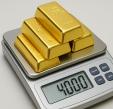Goldman Sachs now sees $4,900 gold by Q2 2026 on rising ETF and steady central bank demand
NEW YORK (October 7) Goldman Sachs has raised its December 2026 gold price forecast from $4,300 to $4,900 per ounce, according to a research note published on Monday.
The investment bank expects the added gains will be driven by strong Western exchange-traded fund (ETF) inflows and sustained central bank buying.
“We see the risks to our upgraded gold price forecast as still skewed to the upside on net, because private sector diversification into the relatively small gold market may boost ETF holdings above our rates-implied estimate,” Goldman analysts wrote. The bank expects Western ETF holdings to rise as the Federal Reserve lowers the funds rate by 100 basis points by Q2 2026, they said.
Goldman also projects central bank buying will average 80 tonnes in 2025 and 70 tonnes in 2026, and said emerging market central banks are likely to continue to diversify their reserves away from the U.S. dollar and into gold.
Spot gold is up 52% year-to-date on the back of strong central bank buying, increased demand for gold-backed ETFs, a weaker dollar and growing interest from retail investors looking to hedge against trade and geopolitical tensions.
“In contrast, noisier speculative positioning has remained broadly stable. Following the large September increase, the level of Western ETF holdings has now fully caught up with our U.S. rates-implied estimate, suggesting the recent ETF strength is not an overshoot,” the analysts said.
On Oct. 1, Goldman Sachs Research led by analyst Lina Thomas said gold prices will gain an additional 6% by the middle of 2026 as fresh demand from key groups of buyers will drive the yellow metal to new record highs.
They said the new forecast is driven by “strong structural demand from central banks and easing from the US Federal Reserve (which supports ETF demand for gold).”
The analysts said buyers of gold fall into two broad groups. “Conviction buyers tend to purchase the yellow metal consistently, regardless of the price, and based on their view on the economy or to hedge risk,” they said. “These include central banks, exchange-traded funds, and speculators. Their thesis-driven flows set the price direction.”
“As a rule of thumb, every 100 tonnes of net purchases by these conviction holders corresponds to a 1.7% rise in the gold price,” they noted.
On the other hand, opportunistic buyers – including households in emerging markets – enter the market only when they believe the price is right. “They may provide a floor under prices on the way down and resistance on the way up,” the analysts said.
According to Goldman Sachs Research’s nowcast of central bank activity, central banks purchased less gold in July than the monthly average for 2025. “Central banks have purchased 64 tonnes of gold per month this year, which is below Goldman Sachs Research’s forecast of 80 tonnes per month,” the report stated.
“This is consistent with the seasonal pattern,” Thomas said. “Central bank purchases tend to slow in the summer and re-accelerate from September. But the seasonal pattern supports our unchanged central bank outlook.”
“At the same time, speculative positioning in derivatives markets by large investors like hedge funds appears significantly bullish on gold,” the report noted. “The amount of net long gold bets on the futures and options exchange COMEX is in its 73rd percentile since 2014 as speculators build up their long positions betting on gold prices to rise.”
Goldman Sachs Research said at the time that gold prices are more likely to exceed their analysts’ $4,000 forecast than to undershoot it. However, the increase in long gold positions, a bet that prices will rise, “raises the risk of tactical pullbacks” as speculators’ net bets on gold tend to revert to the mean over time, Thomas said.
On September 26, Goldman Sachs Research advised investors to diversify through commodities like gold to protect against unexpected financial market tail risks.
“Equity-bond portfolios aren’t well protected against stagnant economic growth and elevated inflation in two situations in particular: when global policy uncertainty is elevated (e.g., markets debating the central bank’s ability to contain inflation) and when the economy is hit by a supply shock (such as a sudden interruption in energy supplies),” the report noted. “For example, gold prices jumped in the 1970s as pronounced spending by the US government and reduced central bank credibility stoked inflation.”
“Gold surged as investors sought value outside the system,” Thomas wrote in the report.
Commodities were also among the few assets that rose in inflation-adjusted terms when Russian gas to Europe was cut off in 2022. Goldman Sachs Research noted that during any 12-month period during which both stocks and bonds delivered negative real returns, either commodities or gold delivered positive performance.
Commodities can also protect portfolios against trade volatility, with Thomas pointing out that commodity supplies are becoming more concentrated, and countries are using their control over resources as geopolitical leverage.
“The growing use of commodities as leverage may reinforce the diversification benefits of commodities in portfolios,” Thomas said.
KitcoNews










